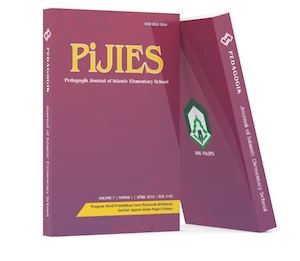The Role of the Let’s Read Application in Increasing Reading Interest among Elementary School Children: A Case in South Tangerang
DOI:
https://doi.org/10.24256/pijies.v8i2.7809Keywords:
let’s read app, school-aged child, reading habitsAbstract
The current research aims to investigate the progress of reading habits through Let’s Readapp and explore more the factors affected of the enhancement of reading habits. Further, the research employed a qualitative case study design with a sixth-grade student at SD Negeri Cirende 2, South Tangerang as the key informant. Then, the data were collected through semi-structured interviews and observations, then analyzed descriptively to provide clear insights. Therefore, the research indicated that several factors influenced Vida in her reading habits. For instance, it could be seen from the exposure of reading, reading interests, and the availability of book resources. Additionally, Let’s Read app possessed some substantial roles in Vida’s reading habits, including simple vocabularies for basic learners, learning grammar from the stories, eye-catching pictures, various languages, and a plenty of themes. To sum up, Let’s Read app was able to applied as the effective solution in promoting reading habits for a school-aged child.
References
Abbas, S. G., & Shaheen, F. (2023). Investigating the impact of digital vs. traditional reading habits on comprehension and engagement among middle school students. Educational Administration: Theory and Practice, 30(5), 4664–4672. https://doi.org/10.53555/kuey.v30i6.7835
Abidin, Y., Rakhmayanti, F., & Undayasari, D. (2025). Factors affecting literacy ability of elementary school students in Indonesia. Mimbar Sekolah Dasar, 12(2), 179–192. https://doi.org/10.53400/mimbar-sd.v12i2.86486
Al Arif, T. Z., Armiwati, A., & Handayani, R. (2023). The use of ICT for English language learning: A mixed-method study of EFL university students. IJELTAL (Indonesian Journal of English Language Teaching and Applied Linguistics), 8(2), 199. https://doi.org/10.21093/ijeltal.v8i2.1554
Apdillah, D., Simanjuntak, C. R. A., Napitupulu, C. N. S. B. R., Sirait, D. D., & Mangunsong, J. (2022). The role of parents in educating children in the digital age. Romeo: Review of Multidisciplinary Education, Culture and Pedagogy, 1(3), 1–8. https://doi.org/10.55047/romeo.v1i3.168
Bresó-Grancha, N., Jorques-Infante, M. J., & Moret-Tatay, C. (2022). Reading digital- versus print-easy texts: A study with university students who prefer digital sources. Psicologia: Reflexao e Critica, 35(1), 1–9. https://doi.org/10.1186/s41155-022-00212-4
Chen, D., & MacLeod, G. (2021). Effectiveness of digital tools to support pupils' reading in secondary school: A systematised review. International Journal of Mobile and Blended Learning, 13(2), 1–16. https://doi.org/10.4018/IJMBL.2021040101
Creswell, J. W. (2012). Educational research: Planning, conducting, and evaluating quantitative and qualitative in educational research. PEARSON.
Farantika, D., Afrezah, N. N., Salhah, S., Asiah, A., & Yafie, E. (2024). Enhancing creative thinking in preschoolers: Teacher strategies for creating a multiliteracy-based learning environment. JPUD - Jurnal Pendidikan Usia Dini, 18(1), 232–250. https://doi.org/10.21009/JPUD.181.17
Hasniza, H., Romar, R., & Yanti, I. (2023). The causal relationship between self-determination and academic motivation among high-school students in Banda Aceh. Forum Paedagogik, 13(2), 208–219. https://doi.org/10.24952/paedagogik.v13i2.6296
Krishna Pasupuleti, M. (2024). Strategies for bridging the digital divide in rural and low-income communities. Digital Divide and Technology Access, 4(9), 106–135. https://doi.org/10.62311/nesx/9029
Kucirkova, N. (2019). Children's reading with digital books: Past moving quickly to the future. Child Development Perspective, 13(4), 208–214. https://doi.org/10.1111/cdep.12339
Lustyantie, N., & Aprilia, F. (2020). Reading interest and achievement motivation: A study in an EFL context. TESOL International Journal, 15(4), 147–166.
Mahmood, M. A. (2022). The role of reading in enhancing EFL learners' language proficiency. Qalaai Zanist Scientific Journal, 7(4), 1168–1196. https://doi.org/10.25212/lfu.qzj.7.4.49
Mcleod, S. (2024). Vygotsky’s theory of cognitive development Vygotsky’s theory of cognitive development. Simply Psychology, 84(8), 224–252. https://doi.org/10.5281/zenodo.15680745
Mulyani, P. K. (2022). The effect of parental absence on children's literacy development: A case study of a fourth-grade elementary school student. Vision: Journal for Language and Foreign Language Learning, 11(2), 107–124. https://doi.org/10.21580/vjv12i116052
Oclaret, V. (2021). Impact of academic intrinsic motivation facets on students' academic performance.
Pham, U. M. N. (2021). The effects of reading habits on reading comprehension among EFL students at Van Lang University. IJTE (International Journal of TESOL & Education), 1(2), 15–44. https://doi.org/10.11250/ijte.01.02.002
Pitaloka, N. P. R. C., Suprianti, G. A., & Wahyuni, L. G. E. (2024). Improving the use of learning media through the development of e-storybooks for fifth-grade students. Journal of Education Technology, 8(3), 484–493. https://doi.org/10.23887/jet.v8i3.81100
Purwandari, S., Triana, P. M., & Mayawati, A. I. (2023). How parents involve in cultivating children's reading interests. Dalam International conference on social science and education (hlm. 704-708). https://doi.org/10.2991/978-2-494069-49-7_117
Sakti, S. A., Endraswara, S., & Rohman, A. (2024). Integrating local cultural values into early childhood education to promote character building. International Journal of Learning, Teaching and Educational Research, 23(7), 84–101. https://doi.org/10.26803/ijlter.23.7.5
Segers, E., & Kleemans, T. (2020). The impact of the digital home environment on kindergartners' language and early literacy. Frontiers in Psychology, 11(9), 1–9. https://doi.org/10.3389/fpsyg.2020.538584
Taye, T., & Teshome, G. (2025). The efficacy of extensive reading strategies for enhancing reading comprehension among 4th year EFL students at Mizan Tepi University. Social Sciences and Humanities Open, 11(6), 1–11. https://doi.org/10.1016/j.ssaho.2025.101616
Tembulkar, A., & Lele, U. (2021). Potential for use of educational app for young children. IOSR Journal of Research & Method in Education, 11(4), 30–37. https://doi.org/10.9790/7388-1104033037
Varga, E., & Daróczi, G. (2024). The role of interactive books in the development of reading and reading comprehension.
Wardani, D. A. P., Pujiastutik, E. F., & Sholekha, N. (2024). Efektivitas model pembelajaran project based learning terhadap kemampuan literasi numerasi untuk meningkatkan berfikir kritis siswa. Primary Education Journals (Jurnal Ke-SD-An), 4(3), 321–326. https://doi.org/10.36636/primed.v4i3.5892
Yan, W., Lowell, V. L., & Yang, L. (2024). Developing English language learners' speaking skills through applying a situated learning approach in VR-enhanced learning experiences. Virtual Reality, 28(4). https://doi.org/10.1007/s10055-024-01061-5
Downloads
Published
How to Cite
Issue
Section
Citation Check
License
Copyright (c) 2025 Firdaus Habibi, Erniyanti Nur Fatahhela Dewi

This work is licensed under a Creative Commons Attribution-ShareAlike 4.0 International License.
Copyright notice:
Authors retain copyright and grant the journal right of first publication with the work simultaneously licensed under an Attribution-ShareAlike 4.0 International (CC BY-SA 4.0) (https://creativecommons.org/licenses/by-sa/4.0/) that allows others to share the work with an acknowledgement of the work's authorship and initial publication in this journal.
Authors are able to enter into separate, additional contractual arrangements for the non-exclusive distribution of the journal's published version of the work (e.g., post it to an institutional repository or publish it in a book), with an acknowledgement of its initial publication in this journal.
Authors are permitted and encouraged to post their work online (e.g., in institutional repositories or on their website) prior to and during the submission process, as it can lead to productive exchanges, as well as earlier and greater citation of published work (See the Effect of Open Access)







 This is an open access article under the
This is an open access article under the 